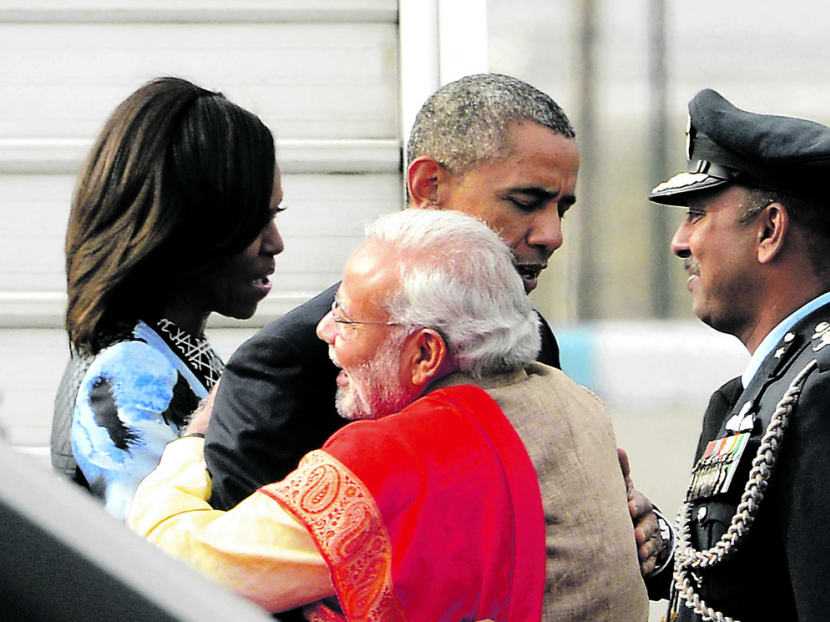US-India partnership set to move to new level
NEW DELHI — United States President Barack Obama swept aside past friction with India yesterday to report progress on climate change and civilian nuclear power cooperation as he sought to transform a fraught relationship marked by suspicion into an enduring partnership linking the world’s oldest and largest democracies.

Indian Premier Narendra Modi and US President Barack Obama greeting each other with a hug as Mrs Michelle Obama looks on at Palam Air Force Station in New Delhi yesterday. Mr Obama is the first US leader to visit India twice during his presidency. Photo: AP
NEW DELHI — United States President Barack Obama swept aside past friction with India yesterday to report progress on climate change and civilian nuclear power cooperation as he sought to transform a fraught relationship marked by suspicion into an enduring partnership linking the world’s oldest and largest democracies.
Kicking off a three-day visit rich in symbolism and pageantry, Mr Obama emerged from hours of discussions with Indian Prime Minister Narendra Modi with what he called “a breakthrough understanding” to finally overcome years of deadlock that have prevented American firms from building nuclear reactors in India, a key goal of the trip.
Mr Obama and Mr Modi also renewed a 10-year defence pact, agreed to joint military hardware production and resolved to work together to reduce the threat of greenhouse gas emissions. But the climate agreement included mostly minor initiatives compared with the deal Mr Obama made with China last November. It was also unclear whether American industrial firms would agree the nuclear pact offered sufficient protection from potential liability in the case of mishap to justify the investment.
Still, the atmosphere of amity was palpable as Mr Modi broke with protocol to greet Mr Obama at the airport with a warm handshake and hug. The Indian Prime Minister, who pays meticulous attention to symbolic messages of high-level meetings, immediately made it clear yesterday with his decision to greet Mr Obama with an embrace that his relationship with the US is a warm and trusting one.
In the past, Mr Modi has reserved such greetings for leaders who were trusted partners, such as Japanese Prime Minister Shinzo Abe and, more recently, Australian Prime Minister Tony Abbott.
During a later joint appearance, Mr Modi referred to the US President as Barack and thanked him for his “deep personal commitment” to their developing friendship. “It’s not surprising then that we had a friendship because, hopefully, we’re reflecting the values of our peoples,” Mr Obama replied. “That affection can then be translated into specific actions.”
Mr Obama’s visit, his second as President, is a major event in India. Despite lingering distrust in many parts of the government, largely over Washington’s history of support for rival Pakistan, the US enjoys widespread popularity among the general population.
Mr Obama’s arrival was marred to some extent by his decision, announced just as he left Washington, to cut the visit short by several hours and skip a tour of the iconic Taj Mahal to fly to Saudi Arabia tomorrow to pay his respects to the family of King Abdullah Abdul Aziz Al Saud, who died on Friday.
The display of friendship stands in stark contrast to the state of ties only a year ago after the arrest and strip-search of Indian diplomat Devyani Khobragade, who was accused of exploiting a housekeeper in New York. Mr Obama and Mr Modi have made it a priority to move beyond that dispute.
Ms Neelam Deo, a long-time Indian diplomat who now heads Mumbai-based foreign policy research organisation Gateway House, said Mr Modi would distinguish himself principally by projecting a simple message about the US.
“It is a moment where the coyness of the previous government has been set aside,” she said. “That is not his style. He is pretty explicit. I would say he has gone all the way to project the message — and there is nothing ideological about this — that the US is the most important country in the world for us. It’s what we look for.”
Foreign policy has been a central focus of Mr Modi’s first months in office. He has made it a priority to project a more forceful leadership role for India among its South Asian neighbours, challenging China’s growing partnerships with leaders of Sri Lanka and the Maldives. He is also exploring deeper economic ties with China, though a visit by Chinese President Xi Jinping was marred by tension over the disputed border between the two nations.
A breakthrough on the nuclear issue would provide both leaders a tangible achievement from the visit. Former US President George W Bush reached agreement with India in 2006 to end a decades-long moratorium on the sale of nuclear fuel and reactor components, while India in exchange would separate civilian and military nuclear schemes and open civilian facilities to global inspections.
But the promise of a thriving new nuclear trade between the powers never materialised because of an Indian law that would hold American energy firms responsible for accidents. US companies sought more protection, while the Indian government argued that Washington should pressure the firms to invest any way.
THE NEW YORK TIMES






